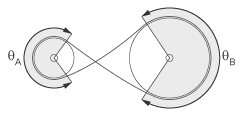Belt Drive
Power transmission system with taut belt connecting two pulleys
Libraries:
Simscape /
Driveline /
Couplings & Drives
Description
The Belt Drive block represents a pair of pulleys
connected with a flexible ideal, flat, or V-shaped belt. When you set Belt
type to Ideal - No slip, the belt does not
slip relative to the pulley surfaces.
The block accounts for friction between the flexible belt and the pulley periphery. If the friction force is not sufficient to drive the load, the block allows slip. The relationship between the tensions in the driving and driven branches conforms to the capstan equation, also known as the Euler-Eytelwein equation. The block accounts for centrifugal loading in the flexible belt, pulley inertia, and bearing friction.
The Belt Drive block is a structural component based on the Simscape™ Driveline™ Belt Pulley block and Simscape Translational Spring and Translational Damper blocks.
The Translational Spring and Translational Damper blocks simulate the compliance of the belt. For the equations governing the contact dynamics between the belt and the pulley, see the Belt Pulley block. The figure shows the functional block diagram for the Belt Drive block.

To learn more about the construction of the block, see About Composite Components and the reference pages for the individual component blocks.
Equations
The diagrams show the open and crossed belt drive configurations. When you set
Drive type to Open belt, both
pulleys tend to rotate in the same direction and the larger pulley has a larger belt
wrap angle. When you set Drive type to Crossed
belt, the pulleys tend to rotate in opposite directions and have
the same wrap angle.
Belt Drive Diagrams

θA is the wrap angle of pulley A.
θB is the wrap angle of pulley B.
RA is the effective radius of pulley A.
RB is the effective radius of pulley B.
C is the distance between the centers of pulleys A and B.
When you set Drive type to Open
belt, the block calculates the wrap angle of the belt around
each pulley as:
The diagram shows the wrap angles and parameters.

When you set Drive type to Crossed
belt, the two wrap angles are equal and the wrap angle of the
belt around each pulley:
The diagram shows the wrap angles and parameters.

Assumptions and Limitations
The pulleys do not translate.
The friction coefficient and friction velocity threshold between the belt and each of the pulleys is the same. To parameterize separate friction interactions, use two Belt Pulley blocks.
Ports
Conserving
Parameters
More About
References
[1] Johnson, Kenneth L. Contact Mechanics. Cambridge: Cambridge Univ. Press, 2003.
Extended Capabilities
Version History
Introduced in R2012a
